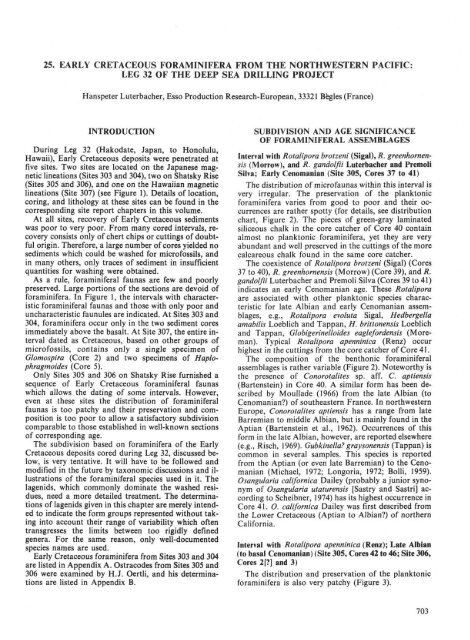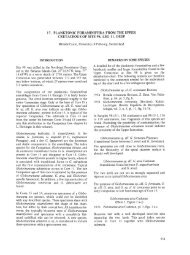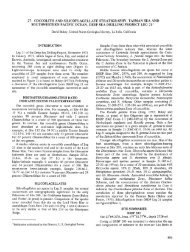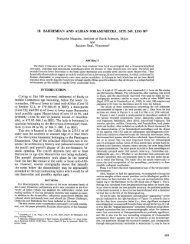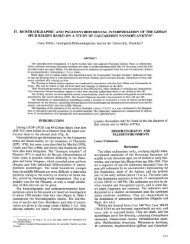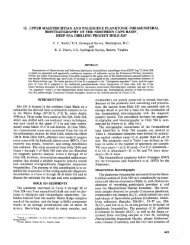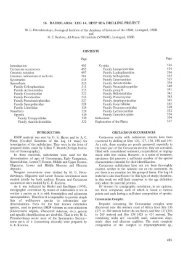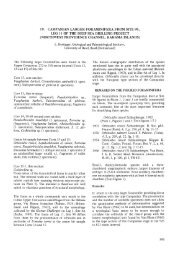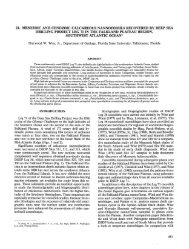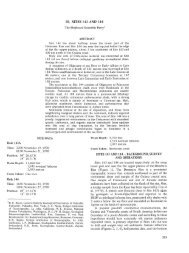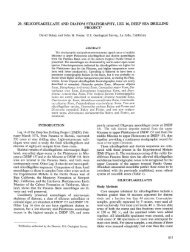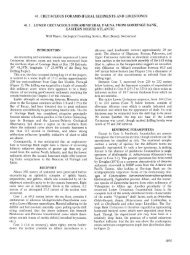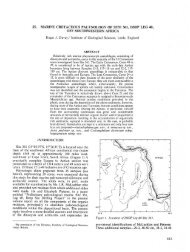25. Early Cretaceous Foraminifera from the Northwestern Pacific ...
25. Early Cretaceous Foraminifera from the Northwestern Pacific ...
25. Early Cretaceous Foraminifera from the Northwestern Pacific ...
You also want an ePaper? Increase the reach of your titles
YUMPU automatically turns print PDFs into web optimized ePapers that Google loves.
<strong>25.</strong> EARLY CRETACEOUS FORAMINIFERA FROM THE NORTHWESTERN PACIFIC:<br />
LEG 32 OF THE DEEP SEA DRILLING PROJECT<br />
Hanspeter Luterbacher, Esso Production Research-European, 33321 Bègles (France)<br />
INTRODUCTION<br />
During Leg 32 (Hakodate, Japan, to Honolulu,<br />
Hawaii), <strong>Early</strong> <strong>Cretaceous</strong> deposits were penetrated at<br />
five sites. Two sites are located on <strong>the</strong> Japanese magnetic<br />
lineations (Sites 303 and 304), two on Shatsky Rise<br />
(Sites 305 and 306), and one on <strong>the</strong> Hawaiian magnetic<br />
lineations (Site 307) (see Figure 1). Details of location,<br />
coring, and lithology at <strong>the</strong>se sites can be found in <strong>the</strong><br />
corresponding site report chapters in this volume.<br />
At all sites, recovery of <strong>Early</strong> <strong>Cretaceous</strong> sediments<br />
was poor to very poor. From many cored intervals, recovery<br />
consists only of chert chips or cuttings of doubtful<br />
origin. Therefore, a large number of cores yielded no<br />
sediments which could be washed for microfossils, and<br />
in many o<strong>the</strong>rs, only traces of sediment in insufficient<br />
quantities for washing were obtained.<br />
As a rule, foraminiferal faunas are few and poorly<br />
preserved. Large portions of <strong>the</strong> sections are devoid of<br />
foraminifera. In Figure 1, <strong>the</strong> intervals with characteristic<br />
foraminiferal faunas and those with only poor and<br />
uncharacteristic faunules are indicated. At Sites 303 and<br />
304, foraminifera occur only in <strong>the</strong> two sediment cores<br />
immediately above <strong>the</strong> basalt. At Site 307, <strong>the</strong> entire interval<br />
dated as <strong>Cretaceous</strong>, based on o<strong>the</strong>r groups of<br />
microfossils, contains only a single specimen of<br />
Glomospira (Core 2) and two specimens of Haplophragmoides<br />
(Core 5).<br />
Only Sites 305 and 306 on Shatsky Rise furnished a<br />
sequence of <strong>Early</strong> <strong>Cretaceous</strong> foraminiferal faunas<br />
which allows <strong>the</strong> dating of some intervals. However,<br />
even at <strong>the</strong>se sites <strong>the</strong> distribution of foraminiferal<br />
faunas is too patchy and <strong>the</strong>ir preservation and composition<br />
is too poor to allow a satisfactory subdivision<br />
comparable to those established in well-known sections<br />
of corresponding age.<br />
The subdivision based on foraminifera of <strong>the</strong> <strong>Early</strong><br />
<strong>Cretaceous</strong> deposits cored during Leg 32, discussed below,<br />
is very tentative. It will have to be followed and<br />
modified in <strong>the</strong> future by taxonomic discussions and illustrations<br />
of <strong>the</strong> foraminiferal species used in it. The<br />
lagenids, which commonly dominate <strong>the</strong> washed residues,<br />
need a more detailed treatment. The determinations<br />
of lagenids given in this chapter are merely intended<br />
to indicate <strong>the</strong> form groups represented without taking<br />
into account <strong>the</strong>ir range of variability which often<br />
transgresses <strong>the</strong> limits between too rigidly defined<br />
genera. For <strong>the</strong> same reason, only well-documented<br />
species names are used.<br />
<strong>Early</strong> <strong>Cretaceous</strong> foraminifera <strong>from</strong> Sites 303 and 304<br />
are listed in Appendix A. Ostracodes <strong>from</strong> Sites 305 and<br />
306 were examined by H.J. Oertli, and his determinations<br />
are listed in Appendix B.<br />
SUBDIVISION AND AGE SIGNIFICANCE<br />
OF FORAMINIFERAL ASSEMBLAGES<br />
Interval with Rotalipora brotzeni (Sigal), R. greenhornensis<br />
(Morrow), and R. gandolfii Luterbacher and Premoli<br />
Silva; <strong>Early</strong> Cenomanian (Site 305, Cores 37 to 41)<br />
The distribution of microfaunas within this interval is<br />
very irregular. The preservation of <strong>the</strong> planktonic<br />
foraminifera varies <strong>from</strong> good to poor and <strong>the</strong>ir occurrences<br />
are ra<strong>the</strong>r spotty (for details, see distribution<br />
chart, Figure 2). The pieces of green-gray laminated<br />
siliceous chalk in <strong>the</strong> core catcher of Core 40 contain<br />
almost no planktonic foraminifera, yet <strong>the</strong>y are very<br />
abundant and well preserved in <strong>the</strong> cuttings of <strong>the</strong> more<br />
calcareous chalk found in <strong>the</strong> same core catcher.<br />
The coexistence of Rotalipora brotzeni (Sigal) (Cores<br />
37 to 40), R. greenhornensis (Morrow) (Core 39), and R.<br />
gandolfii Luterbacher and Premoli Silva (Cores 39 to 41)<br />
indicates an early Cenomanian age. These Rotalipora<br />
are associated with o<strong>the</strong>r planktonic species characteristic<br />
for late Albian and early Cenomanian assemblages,<br />
e.g., Rotalipora evoluta Sigal, Hedbergella<br />
amabilis Loeblich and Tappan, H. brittonensis Loeblich<br />
and Tappan, Globigerinelloides eaglefordensis (Moreman).<br />
Typical Rotalipora apenninica (Renz) occur<br />
highest in <strong>the</strong> cuttings <strong>from</strong> <strong>the</strong> core catcher of Core 41.<br />
The composition of <strong>the</strong> benthonic foraminiferal<br />
assemblages is ra<strong>the</strong>r variable (Figure 2). Noteworthy is<br />
<strong>the</strong> presence of Conorotalites sp. aff. C. aptiensis<br />
(Bartenstein) in Core 40. A similar form has been described<br />
by Moullade (1966) <strong>from</strong> <strong>the</strong> late Albian (to<br />
Cenomanian?) of sou<strong>the</strong>astern France. In northwestern<br />
Europe, Conorotalites aptiensis has a range <strong>from</strong> late<br />
Barremian to middle Albian, but is mainly found in <strong>the</strong><br />
Aptian (Bartenstein et al., 1962). Occurrences of this<br />
form in <strong>the</strong> late Albian, however, are reported elsewhere<br />
(e.g., Risch, 1969). Gubkinella? graysonensis (Tappan) is<br />
common in several samples. This species is reported<br />
<strong>from</strong> <strong>the</strong> Aptian (or even late Barremian) to <strong>the</strong> Cenomanian<br />
(Michael, 1972; Longoria, 1972; Bolli, 1959).<br />
Osangularia californica Dailey (probably a junior synonym<br />
of Osangularia utaturensis [Sastry and Sastri] according<br />
to Scheibner, 1974) has its highest occurrence in<br />
Core 41. O. californica Dailey was first described <strong>from</strong><br />
<strong>the</strong> Lower <strong>Cretaceous</strong> (Aptian to Albian?) of nor<strong>the</strong>rn<br />
California.<br />
Interval with Rotalipora apenninica (Renz); Late Albian<br />
(to basal Cenomanian) (Site 305, Cores 42 to 46; Site 306,<br />
Cores 2[?] and 3)<br />
The distribution and preservation of <strong>the</strong> planktonic<br />
foraminifera is also very patchy (Figure 3).<br />
703
H. LUTERBACHER<br />
AGE<br />
EARLY<br />
CENOMANIAN<br />
LATE<br />
ALBIAN<br />
(to basal C nomanian)<br />
MIDDLE<br />
TO<br />
EARLY<br />
ALBIAN<br />
9<br />
APT IAN<br />
•<br />
BARREMIAN<br />
BARREMIAN<br />
TO<br />
HAUTERIVIAN<br />
EARLY<br />
CRETACEOUS<br />
(undiffereπtiated)<br />
SUBDIVISION<br />
BASED ON<br />
FORAMINIFERA<br />
Interval with<br />
Robalipora brobzem.<br />
Robalipora greenhornen sis<br />
and Kobalipora gandoffii<br />
Interval with<br />
Robalipora apenπinica<br />
Interval with<br />
Ticinella primula<br />
*<br />
Interval with<br />
Globigerinel/oides ferreolensis<br />
Interval between<br />
highest occurrence of<br />
Dorobhia zedlerae<br />
and highest occurrence of<br />
Dorobhia hauberiviana<br />
Interval with<br />
Dorobhia hauberiviana<br />
li<br />
1<br />
1<br />
1T<br />
...A.<br />
-4-<br />
38<br />
39<br />
40<br />
41<br />
42<br />
44<br />
45<br />
46<br />
47<br />
41<br />
49<br />
50<br />
S1<br />
52<br />
53<br />
54<br />
55<br />
57<br />
58<br />
59<br />
60<br />
61<br />
62<br />
63<br />
64<br />
65<br />
66<br />
67<br />
**305<br />
32 β OO,13'N<br />
157*51,OO'E<br />
Water depth.<br />
2903 m<br />
.1 1<br />
Λ<br />
Q<br />
II<br />
||<br />
II<br />
I 1<br />
1<br />
|<br />
I<br />
SHATSKY RISE<br />
2<br />
3<br />
4<br />
5<br />
6<br />
7<br />
β<br />
9<br />
I0<br />
II<br />
12<br />
13<br />
14<br />
15<br />
16<br />
17<br />
18<br />
19<br />
23<br />
24<br />
25<br />
26<br />
27<br />
28<br />
29<br />
30<br />
= 31 =<br />
32<br />
33<br />
34<br />
35<br />
36<br />
37<br />
38<br />
39<br />
40<br />
41<br />
42<br />
4*306<br />
31 β 52,02'N<br />
157 β 28,7rE<br />
Water depth:<br />
3399 m<br />
50<br />
40<br />
-30<br />
20*<br />
| 11*^1<br />
π — 13<br />
~•<br />
A<br />
-Om<br />
-50 m<br />
1000 kin<br />
140*<br />
-100 m<br />
#304<br />
39'20,27'N<br />
155*04,19'E<br />
Water depth:<br />
5630 m<br />
0<br />
150<br />
Φ<br />
#303<br />
•304<br />
306* *<br />
.307 "<br />
160<br />
Interval with poor and/or<br />
uncharacteristic<br />
microfaunas<br />
\<br />
JAPANESE<br />
Interval with<br />
characteristic<br />
microfaunas<br />
7A<br />
8A<br />
#303<br />
40 48.50'N<br />
l54 β<br />
27,O7'E<br />
Water depth:<br />
5609m<br />
MAGNETIC LINEATIONS<br />
Figure 1. Subdivision and correlation based on foraminifera of <strong>the</strong> Lower <strong>Cretaceous</strong> in Sites 303, 304, 305, and 306.<br />
704
Figure 2. Distribution of foraminifera of <strong>the</strong> Lower <strong>Cretaceous</strong> of Site 305.
Figure 3. Distribution of foraminifera of <strong>the</strong> Lower <strong>Cretaceous</strong> of Site 306.
The presence of Rotalipora apenninica (Renz) (sensu<br />
Luterbacher and Premoli Silva, 1962, = Rotalipora<br />
balernaensis Gandolfi sensu Sigal, 1969) and R. evoluta<br />
Sigal indicates a late Albian (to basal Cenomanian) age.<br />
At Site 306, representatives of <strong>the</strong> genus Rotalipora<br />
are only found in Core 3, but Core 2 contains <strong>the</strong> same<br />
Hedbergella species as found in Core 3 and <strong>the</strong>refore is<br />
placed into <strong>the</strong> same interval. The cuttings <strong>from</strong> Core 3<br />
are relatively rich in well-preserved specimens of<br />
Schackoina cenomana (Schacko).<br />
The distribution of <strong>the</strong> benthonic foraminifera in this<br />
interval is shown in Figures 2 and 3.<br />
Interval with Ticinella primula Luterbacher; <strong>Early</strong> to<br />
Middle Albian (Site 305, Cores 47 to 52 [or 54?]; Site 306,<br />
Core 4 [to 7?])<br />
Because of <strong>the</strong> generally poor preservation of <strong>the</strong><br />
microfaunas, <strong>the</strong> accessory apertures typical for <strong>the</strong><br />
genus Ticinella cannot always be seen clearly. The presence<br />
of Ticinella primula in Core 54 of Site 305 and in<br />
Core 7 of Site 306 is <strong>the</strong>refore uncertain.<br />
The earliest occurrence of representatives of <strong>the</strong> genus<br />
Ticinella is within <strong>the</strong> youngest part of <strong>the</strong> Aptian (Sigal,<br />
1966; Longoria, 1972) or at <strong>the</strong> base of <strong>the</strong> Albian (Gorbatchik<br />
and Kretschmar, 1969). Older occurrences cited<br />
in <strong>the</strong> literature are very doubtful (e.g., middle Barremian<br />
in Fuchs, 1972). Ticinella primula ranges throughout<br />
<strong>the</strong> Albian (Sigal, 1966), although it may have its<br />
first occurrence in <strong>the</strong> uppermost Aptian (Longoria,<br />
1972). The limit between <strong>the</strong> Aptian and Albian is here<br />
drawn in coincidence with <strong>the</strong> lowermost occurrence of<br />
representatives of <strong>the</strong> genus Ticinella.<br />
Interval with Globigerinelloides ferreolensis (Moullade);<br />
Aptian (Site 305, Cores 57 [or 54?] to 59)<br />
At Site 306, this interval could not be recognized.<br />
Samples <strong>from</strong> <strong>the</strong> cores between <strong>the</strong> lowermost occurrence<br />
of planktonic foraminifera and <strong>the</strong> highest occurrence<br />
of Dorothia zedlerae (Moullade) (Cores 8 to 11)<br />
are ei<strong>the</strong>r barren or contain only very poor and uncharacteristic<br />
faunules.<br />
The most representative microfauna of this interval is<br />
found in <strong>the</strong> core-catcher sample of Core 57 (Site 305).<br />
Globigerinelloides ferreolensis (Moullade) is here accompanied<br />
by G. barri (Bolli, Loeblich, and Tappan), G.<br />
macrostomata Longoria, Hedbergella aptica (Agalarova),<br />
H. gorbatchiki Longoria, and H. globigerinelloides<br />
(Subbotina). A few specimens of Globigerinelloides<br />
ferreolensis display a strong tendency to uncoil<br />
and in this respect resemble G. algerianus Cushman and<br />
Ten Dam, but <strong>the</strong>y always have fewer chambers and<br />
lack <strong>the</strong> flattened profile typical for <strong>the</strong> latter species.<br />
According to most authors, Globigerinelloides ferreolensis<br />
is restricted to <strong>the</strong> late Aptian (mainly "Gargasian")<br />
(e.g., Moullade, 1966; Gorbatchik and<br />
Kretschmar, 1969; Longoria, 1972). According to Sigal<br />
(1966), <strong>the</strong> species ranges <strong>from</strong> within <strong>the</strong> upper part of<br />
<strong>the</strong> early Aptian ("Bedoulian") into <strong>the</strong> upper part of<br />
<strong>the</strong> late Aptian ("Clansayesian"). G. barri (Bolli, Loeblich,<br />
and Tappan) and G. macrostomata Longoria are<br />
restricted to <strong>the</strong> late Aptian (Longoria, 1972).<br />
EARLY CRETACEOUS FORAMINIFERA<br />
The composition of <strong>the</strong> microfaunas <strong>from</strong> this interval<br />
strongly resembles those <strong>from</strong> <strong>the</strong> "zone à Globigerinelloides''''<br />
of French authors (e.g., Sigal, 1966) ("Gargasian"),<br />
although Globigerinelloides algerianus, <strong>the</strong><br />
most prominent marker of this zone, has not been<br />
found.<br />
Interval Between Highest Occurrence of Dorothia<br />
zedlerae (Moullade) and Highest Occurrence of Dorothia<br />
hauteriviana (Moullade); <strong>Early</strong> Aptian? to Barremain<br />
(Site 305, Cores 64 to 67; Site 306, Cores 12 to 21)<br />
At Site 305, samples <strong>from</strong> Cores 60 to 63 are dominated<br />
by Radiolaria. Only samples <strong>from</strong> Section 1 of<br />
Core 60 and <strong>the</strong> core catcher of Core 63 contain a few<br />
benthonic foraminifera. Gubkinella? graysonensis (Tappan)<br />
and Osangularia sp. aff. O. insigna Dailey have<br />
<strong>the</strong>ir lowermost occurrences in Core 60.<br />
Dorothia zedlerae (Moullade) appears in Core 64 of<br />
Site 305 and in Core 12 of Site 306. A comparison of <strong>the</strong><br />
two sections, with <strong>the</strong> lowermost occurrence of Rotalipora<br />
apenninica as a datum, indicates that <strong>the</strong> first occurrence<br />
takes place at <strong>the</strong> same subsea depth. At both<br />
sites, Dorothia praeoxycona Moullade and Dorothia sp.<br />
aff. D. kummi (Zedler) appear below <strong>the</strong> first occurrence<br />
of D. zedlerae.<br />
Dorothia zedlerae is known <strong>from</strong> <strong>the</strong> late Valanginian<br />
to <strong>the</strong> early Barremian, D. praeoxycona <strong>from</strong> <strong>the</strong> Barremian<br />
to <strong>the</strong> basal Albian and D. kummi <strong>from</strong> <strong>the</strong> late<br />
Valanginian to <strong>the</strong> Aptian (Moullade, 1966; Douglas<br />
and Moullade, 1972). However, <strong>the</strong> stratigraphic ranges<br />
of <strong>Early</strong> <strong>Cretaceous</strong> representatives of <strong>the</strong> genus Dorothia<br />
are probably less restricted (see e.g., Mayne, 1972).<br />
Too precise age determinations, based on <strong>the</strong>ir published<br />
ranges, should <strong>the</strong>refore be taken with some caution.<br />
The species of <strong>the</strong> group of Dorothia hauteriviana are a<br />
potential tool for <strong>the</strong> correlation of open-marine <strong>Early</strong><br />
<strong>Cretaceous</strong> deposits lacking planktonic foraminifera,<br />
but <strong>the</strong>ir interregional stratigraphic significance needs to<br />
be tested in well-dated sections of several distant<br />
geographic areas.<br />
The planktonic foraminifera found in Cores 64 and 67<br />
at Site 305 are represented by very few specimens. It is<br />
<strong>the</strong>refore somewhat hazardous to use <strong>the</strong>m for age<br />
determinations. Hedbergella aptica (Agalarova) (Core<br />
64) ranges <strong>from</strong> <strong>the</strong> base of <strong>the</strong> Aptian into <strong>the</strong> Albian<br />
(Gorbatchik and Kretschmar, 1969), whereas Globigerinelloides<br />
gottisi (Chevalier) (Core 64) is known<br />
mainly <strong>from</strong> <strong>the</strong> early Aptian, but extends into <strong>the</strong> late<br />
Aptian (Sigal, 1966; Longoria, 1972). This may indicate<br />
that at least <strong>the</strong> upper part of this interval may still be of<br />
early Aptian age, although this would conflict with <strong>the</strong><br />
published range of Dorothia zedlerae. Hedbergella sigali<br />
(Moullade) is represented by only one specimen in Core<br />
67. This species is known mainly <strong>from</strong> <strong>the</strong> Barremian.<br />
The two specimens determined as Hedbergella globigerinelloides<br />
(Subbotina) belong to a long-ranging<br />
species which was first described <strong>from</strong> <strong>the</strong> early Albian.<br />
The common occurrence of Spirillina sp. in <strong>the</strong> corecatcher<br />
sample of Core 20 (Site 306) is noteworthy. They<br />
were determined as Spirillina minima (Schacko), a<br />
species reported throughout <strong>the</strong> <strong>Cretaceous</strong>, and Spirillina<br />
neocomiana Moullade. The latter species is known<br />
<strong>from</strong> <strong>the</strong> Berriasian to <strong>the</strong> Barremian (Moullade, 1966).<br />
707
H. LUTERBACHER<br />
Interval with Dorothia hauteriviana (Moullade); Hauterivian<br />
to Barremian. (Site 303, Core 8A; Site 304, Core 14;<br />
Site 306, Cores 22 to 26)<br />
The microfaunas <strong>from</strong> this interval are similar to<br />
those <strong>from</strong> <strong>the</strong> basal sediments cored at Sites 49 and 50<br />
on Shatsky Rise (Leg 6 of DSDP). Douglas and Moullade<br />
(1972) dated <strong>the</strong>se microfaunas as early Barremian<br />
to late Hauterivian. According to <strong>the</strong>se authors, Dorothia<br />
hauteriviana (Moullade) occurs <strong>from</strong> within <strong>the</strong><br />
Valanginian into <strong>the</strong> early Barremian. The co-occurrence<br />
of Dorothia hauteriviana and D. praeoxycona<br />
would indicate an early Barremian age (Douglas and<br />
Moullade, 1972, fig. 3). However, Mayne (1972) extends<br />
<strong>the</strong> range of Dorothia hauteriviana to <strong>the</strong> Aptian and<br />
basal Albian.<br />
Very rare specimens of Lenticulina ouachensis<br />
ouachensis (Sigal), a species known <strong>from</strong> <strong>the</strong> Hauterivian<br />
to <strong>the</strong> Aptian, are found in Core 22 of Site 306.<br />
At Site 304, almost <strong>the</strong> entire interval attributed to <strong>the</strong><br />
<strong>Early</strong> <strong>Cretaceous</strong> contains no foraminifera. The first<br />
foraminifera are found in cuttings corresponding to<br />
Core 13 which contain a few small lagenids and primitive<br />
arenaceous foraminifera. The two samples of sediments<br />
overlying <strong>the</strong> basalt (Core 14) are dominated by<br />
lagenids, but contain also Dorothia hauteriviana (Moullade),<br />
D. zedlerae (Moullade), D. praeoxycona Moullade,<br />
and D. kummi (Zedler) and are <strong>the</strong>refore attributed<br />
to <strong>the</strong> interval with Dorothia hauteriviana (for faunal<br />
lists, see Appendix A).<br />
Core 8A <strong>from</strong> Site 303, which again is <strong>the</strong> lowermost<br />
sediment core, contains only a poor and badly preserved<br />
microfauna with Dorothia hauteriviana (Moullade),<br />
Dorothia sp. cf. D. praeoxycona Moullade, and Dorothia<br />
sp. cf. D. zedlerae (Moullade), and is <strong>the</strong>refore correlated<br />
with <strong>the</strong> same interval. The overlying Core 7A<br />
contains only very few lagenids and Glomospira sp. (for<br />
faunal lists, see Appendix A).<br />
Interval Below Lowermost Occurrence of Dorothia<br />
hauteriviana (Moullade); <strong>Early</strong> <strong>Cretaceous</strong> (undifferentiated)<br />
(Site 306, Cores 27 to 42)<br />
Below Core 26 of Site 306, foraminifera are very rare.<br />
The microfaunas in <strong>the</strong> few cores <strong>from</strong> which residues<br />
could be obtained are generally dominated by Radiolaria.<br />
Occasionally, a few lagenids could be determined<br />
(Figure 3), but <strong>the</strong>y are insufficient to date <strong>the</strong> samples<br />
and indicate merely a broad <strong>Early</strong> <strong>Cretaceous</strong> (Neocomian)<br />
age.<br />
ACKNOWLEDGMENTS<br />
I wish to thank <strong>the</strong> Deep Sea Drilling Project for inviting me<br />
to participate on Leg 32. The management of Esso Production<br />
Research-European granted <strong>the</strong> necessary time and assistance<br />
to take part in Leg 32 and to prepare this initial report. The<br />
scanning electron micrographs were made by R. Hockett, Exxon<br />
Production Research Company, Houston. J.F. Longoria<br />
allowed me to use <strong>the</strong> manuscript of his <strong>the</strong>sis; H.M. Bolli<br />
gave me copies of <strong>the</strong> manuscripts dealing with <strong>the</strong> <strong>Early</strong> <strong>Cretaceous</strong><br />
foraminifera recovered during Leg 27.<br />
708<br />
REFERENCES<br />
Bartenstein, H. et al., 1962. Leitfossilien der Mikropalaontologie:<br />
Ein Abriss herausgegeben von einem<br />
Arbeitskreis deutscher Mikropalaontologen. Berlin-Nikolassee<br />
(Gebr. Borntraeger) 432 p.<br />
Bolli, H.M., 1959. Planktonic foraminifera <strong>from</strong> <strong>the</strong><br />
<strong>Cretaceous</strong> of Trinidad, B.W.I.: Am. Paleontol. Bull., v. 38,<br />
p. 253-278.<br />
Douglas, R.G. and Moullade, ML, 1972. Age of <strong>the</strong> basal<br />
sediments on <strong>the</strong> Shatsky Rise, western North <strong>Pacific</strong><br />
Ocean: Geol. Soc. Am. Bull., v. 83, p. 1163-1168.<br />
Drushchits, V.V. and Kudryatsev, M.P. (Ed.), 1960. Atlas<br />
nizhnemelovoi fauny Severnovo Kavkaza i Kryma: Moscow<br />
(Gostoptekhizdat).<br />
Fuchs, W., 1971. Eine alpine Foraminiferenfauna des tieferen<br />
Mittel-Barreme aus den Drusbergschichten von Ranzenberg<br />
bei Hohenems in Voralberg. Abh. Geol. Bundesanst.<br />
(Wien), no. 27.<br />
Gorbatchik, T.N. and Kretschmar, V., 1969. Rastchlenenie<br />
apt-albskikh otlozhenii Kryma po planktonnym foraminiferam.<br />
Viestnik Moskov. Univ. Geol., 1969, no. 3, p. 46-<br />
56.<br />
Loeblich, A.R., Jr. and Tappan, H., 1961. <strong>Cretaceous</strong><br />
planktonic foraminifera: Part I—Cenomanian: Micropaleontology,<br />
v. 7, p. 257-304.<br />
Longoria, J.F., 1972. Stratigraphic, morphologic and taxonomic<br />
studies of Aptian planktonic foraminifera: Thesis<br />
Univ. Texas at Dallas.<br />
Luterbacher, H. and Premoli Silva, I., 1962. Note préliminaire<br />
sur une revision du profil de Gubbio, Italie: Riv. Ital.<br />
Paleontol., v. 68, p. 253-288.<br />
Mayne, W., 1972. Lower <strong>Cretaceous</strong> foraminiferal fauna <strong>from</strong><br />
Gorringe Bank, eastern North Atlantic. In Ryan, W.B.F.,<br />
Hsü, K.J., et al., Initial Reports of <strong>the</strong> Deep Sea Drilling<br />
Project, vol. 13: Washington (U.S. Government Printing<br />
Office), p. 1075-1111.<br />
Michael, F.Y., 1972. Planktonic foraminifera <strong>from</strong> <strong>the</strong><br />
Comanchean Series (<strong>Cretaceous</strong>) of Texas: J. Foram. Res.,<br />
v. 2, p. 191-220.<br />
Moullade, M., 1966. Etude stratigraphique et micropaléontologique<br />
du Crétacé inférieur de la "Fosse vocontienne."<br />
Doc. Lab. Géol. Fac. Sci. Lyon, no. 15, 2 vols., 369<br />
P<br />
, 1974. Zones de foraminifères du Crétacé inférieur<br />
mésogéen. C.R. Acad. Sci. Paris, sér. D., t. 278. no. 14, p.<br />
1813-1816.<br />
Risch, H., 1971. Stratigraphic der höheren Unterkreide der<br />
bayerischen Kalkalpen mit Hilfe von Mikrofossilien:<br />
Palaeontographica Abt. A, no. 138, 80 p.<br />
Scheibnerova, V., 1974. Aptian-Albian benthonic foraminifera<br />
<strong>from</strong> DSDP Leg 27 sites 259, 260 and 263 in <strong>the</strong><br />
eastern Indian Ocean: Manuscript.<br />
Sigal, J., 1966. Contribution à une monographie des Rosalines:<br />
1. Le genre Ticinella Reichel, souche des Rotalipores.<br />
Eclog. Geol. Helv., v. 59, p. 185-218.<br />
, 1969. Contribution à une monographie des Rosalines:<br />
2. L'espèce Rotalipora appenninica (O. Renz, 1936),<br />
origine phylétique et taxinomie: 1st Internatl. Conf. Plankt.<br />
Microfossils, Proc, Geneva 1967, v. 2, Leiden (E.J. Brill),<br />
p. 622-639.<br />
APPENDIX A<br />
<strong>Early</strong> <strong>Cretaceous</strong> <strong>Foraminifera</strong> <strong>from</strong> Sites 303 and 304<br />
Because of <strong>the</strong> scarcity of samples containing foraminifera, no distribution<br />
charts were prepared for Sites 303 and 304. The forms determined<br />
in <strong>the</strong>se two sites are <strong>the</strong>refore given in <strong>the</strong> following lists.
Site 303:<br />
Sample 7A, CC: very poor and poorly preserved faunule.<br />
Glomospira sp. sp. (a.o. G. irregularis [Grzybowski], G. charoides<br />
[Parker and Jones])<br />
Astacolus sp. sp. (a.o. A. planiusculus [Reuss], Astacolus sp. aff. A.<br />
major [Bornemann])<br />
Pseudonodosaria humilis (Roemer)<br />
Ramulina sp.<br />
Sample 8A, CC: very poor and poorly preserved microfauna.<br />
Hyperamminá 1 . sp.<br />
Haplophragmoides concavus (Chapman)<br />
Dorothia hauteriviana (Moullade)<br />
Dorothia sp. cf. D. praeoxycona Moullade<br />
Dorothia sp. cf. D. zedlerae (Moullade)<br />
Lenticulina sp. sp. ex gr. L. muensteri (Roemer)<br />
Astacolus vetustus (d'Orbigny)<br />
Marginulinopsis sp. cf. M. parked (Reuss)<br />
Vaginulina biochei Ber<strong>the</strong>lin<br />
Dentalina sp. sp. (a.o. D. communis d'Orbigny, D. linearis Reuss,<br />
D. legumen Reuss)<br />
Nodosaria sp. aff. N. sceptrum Reuss<br />
Pseudonodosaria humilis (Roemer)<br />
Ramulina sp.<br />
Site 304<br />
Core 13, "cuttings" <strong>from</strong> core catcher: very poor microfauna, composed<br />
mainly by small lagenids, relatively well preserved.<br />
Hyperamminai sp.<br />
Tolypamminai sp.<br />
Haplophragmoides^. sp.<br />
Lenticulina sp. sp. ex gr. L. muensteri (Roemer)<br />
Lenticulina sp. aff. L. crassata Kaptarenko-Chernoussova<br />
Lenticulina nodosa (Reuss)<br />
Astacolus calliopsis (Reuss)<br />
Astacolus planiusculus (Reuss)<br />
Marginulinopsis parkeri (Reuss)<br />
Dentalina sp. sp. (a. o. D. communis d'Orbigny, D. serrata<br />
Eichenberg, D. cylindroides Reuss, D.I debilis Ber<strong>the</strong>lin)<br />
Nodosaria sp. sp.<br />
Pseudonodosaria humilis (Roemer)<br />
Globulina sp.<br />
Core 14, Section 1 (strongly disturbed core): relatively rich but poorly<br />
preserved microfauna dominated by lagenids and Dorothia sp. sp.<br />
Hyperamminal sp.<br />
Tolypamminal sp.<br />
Ammodiscus tenuissimus (Guembel)<br />
Glomospira sp. sp. (a. o. G. charoides [Parker and Jones])<br />
Haplophragmoidesi sp.<br />
Textularia sp. aff. T. inversa (Terquem)<br />
Eggerellal sp.<br />
Arenobulimina sp.<br />
Dorothia hauteriviana (Moullade)<br />
Dorothia praeoxycona Moullade<br />
Dorothia kummi (Zedler)<br />
Dorothia sp.<br />
Lenticulina sp. sp. ex gr. L. muensteri (Roemer)<br />
Lenticulina crassata Kaptarenko-Chernoussova<br />
Lenticulina sp. ex gr. L. quenstedti (Guembel)<br />
Lenticulina subalata (Reuss)<br />
Darbyella sp. aff. D. calva (Wisniewski)<br />
Astacolus calliopsis (Reuss)<br />
Astacolus dilectus (Reuss)<br />
Astacolus planiusculus (Reuss)<br />
Astacolus vetustus (d'Orbigny)<br />
EARLY CRETACEOUS FORAMINIFERA<br />
Frondicularia sp.<br />
Vaginulina biochei Ber<strong>the</strong>lin<br />
Dentalina sp. sp. (a. o. D. cylindroides Reuss, D. terquemi d'Orbigny,<br />
DP. debilis Ber<strong>the</strong>lin)<br />
Pseudonodosaria humilis (Roemer)<br />
Lingulina pupa (Terquem)<br />
Globulina sp.<br />
Ramulina sp.<br />
Sample 14, CC: relatively rich, but poorly preserved assemblage<br />
dominated by lagenids and Dorothia sp. sp.<br />
Hyperamminá sp.<br />
Tolypamminal sp.<br />
Glomospira sp.<br />
Ammodiscus sp. sp.<br />
Haplophragmoides concavus (Chapman)<br />
Dorothia hauteriviana (Moullade)<br />
Dorothia kummi (Zedler)<br />
Dorothia praeoxycona Moullade<br />
Dorothia sp.<br />
Lenticulina sp. sp. ex gr. L. muensteri (Roemer)<br />
Lenticulina crassata Kaptarenko-Chernoussova<br />
Lenticulina sp. aff. L. nodosa (Reuss)<br />
Lenticulina subalata (Reuss)<br />
Darbyella sp. aff. D. calva (Wisniowski)<br />
Astacolus calliopsis (Reuss)<br />
Astacolus sp. aff. A. insectus (Schwager)<br />
Astacolus planiusculus (Reuss)<br />
Astacolus vetustus (d'Orbigny)<br />
Marginulinopsis parkeri (Reuss)<br />
Frondicularia sp.<br />
Vaginulina biochei Ber<strong>the</strong>lin<br />
Dentalina communis d'Orbigny<br />
Dentalina linearis (Roemer)<br />
Dentalina serrata Eichenberg<br />
Nodosaria sp. sp.<br />
Pseudonodosaria humilis (Roemer)<br />
Lingulina sp. aff. L. biformis Bartenstein and Brand<br />
Globulina sp.<br />
Pyrulina sp. aff. P. gutta d'Orbigny<br />
Ramulina sp. sp.<br />
APPENDIX B<br />
<strong>Early</strong> <strong>Cretaceous</strong> Ostracodes<br />
The washed residues <strong>from</strong> <strong>the</strong> <strong>Early</strong> <strong>Cretaceous</strong> sections cored during<br />
Leg 32 contain only very few ostracodes. They were submitted to<br />
H.J. Oertli (SNPA, Pau) for examination. He determined <strong>the</strong> following<br />
forms:<br />
Site 305:<br />
Sample 41, CC—Cy<strong>the</strong>rella sp.<br />
Sample 46, CC—Cy<strong>the</strong>rella sp.<br />
Sample 64, CC—Bythocypris sp.<br />
Site 306:<br />
Sample 3, CC—Cy<strong>the</strong>rella sp., Brachycy<strong>the</strong>re sp.<br />
Sample 24, CC—Bairdia sp. sp.<br />
Sample 37, CC—Bairdia sp.<br />
Sample 38, CC—Bairdia sp.<br />
Sample 41-1, 126-128 cm—Bairdia sp., Robsoniellal sp.<br />
Sample 42-1, 116-118 cm—Bairdia sp., Bythocypris sp.<br />
In addition, he states: "Ostracodes are very scarce throughout,<br />
poorly preserved and monotonous in <strong>the</strong>ir generic and specific configuration.<br />
Of none of <strong>the</strong> above mentioned species, identity with<br />
known species could be found. The generic composition seems to be<br />
that of an oceanic (deeper than shelf) environment."<br />
709
H. LUTERBACHER<br />
710<br />
PLATE 1<br />
All figures ×75. (a) spiral view; (b) umbilical view; (c) lateral view.<br />
Figure 1 Rotalipora brotzeni (Sigal), 305-39, CC.<br />
Figure 2 Rotalipora apenninica (Renz), 305-41, CC.<br />
Figure 3 Rotalipora gandolßi Luterbacher and Premoli<br />
Silva, 305-39, CC.<br />
Figures 4, 5 Globigerinelloides eaglefordensis (Moreman), 306-<br />
3, CC.<br />
Figures 6, 7 ISchackoina cenomana (Schacko), 306-3, "cuttings."<br />
Figure 8 Hedbergella delrioensis (Carsey), 305-46, CC.<br />
Figures 9, 10 Hedbergella amabilis Loeblich and Tappan.<br />
9. 306-3, CC.<br />
10. 306-4-1, 120-122 cm.
EARLY CRETACEOUS FORAMINIFERA<br />
711
H. LUTERBACHER<br />
712<br />
PLATE2<br />
All figures ×75. (a) spiral view; (b) umbilical view; (c) lateral view.<br />
Figure 1 Hedbergella brittonensis Loeblich and Tappan,<br />
305-44, CC.<br />
Figure 2 Globigerinelloides sp., 305-57, CC.<br />
Figure 3 Ticinella sp. aff. T. madecassiana Sigal, 305-57,<br />
CC.<br />
Figures 4-8 Gubkinella^l) graysonensis (Tappan).<br />
4. 305-60-1, 100-102 cm.<br />
5. 305-42, CC.<br />
6. 306-44, CC.<br />
7. 8. 305-46, CC.<br />
Figure 9 Conorotalites sp. aff. C. aptiensis (Bettenstaedt),<br />
305-40, "cuttings."<br />
Figures 10, 11 Osangularia califomica Dailey, 305-46, CC.<br />
Figure 12 Vaginulina biochei Ber<strong>the</strong>lin, 306-20, CC.
EARLY CRETACEOUS FORAMINIFERA<br />
713
H. LUTERBACHER<br />
714<br />
PLATE 3<br />
(a) spiral view; (b) umbilical view.<br />
Figures 1,2 Darbyella sp. aff. D. calva (Wisniowski), ×75.<br />
1. 304-14, 1.<br />
2. 304-14, CC.<br />
Figures 3, 4 Pleurostomella reussi Ber<strong>the</strong>lin, 305-60-1, 100-102<br />
cm. ×75.<br />
Figure 5 Dentalina sp., 306-38, CC. ×75.<br />
Figures 6-8 Ramulina sp. ×75.<br />
6. 305-57, CC.<br />
7. 305-46, CC.<br />
8. 306-38, CC.<br />
Figure 9 Marginulina inaequalis Reuss, 306-22, CC. ×75.<br />
Figures 10, 11 Spirillina neocomiana Moullade, 306-20, CC. ×75.<br />
Figure 12 Spirillina minima Schacko, 306-20, CC. ×75.<br />
Figures 13, 14 Spirillina minima Schacko, 306-20, CC. ×150.<br />
Figure 15 Pseudoclavulina gaultina (Morozova), 306-3, "cuttings."<br />
×50.<br />
Figure 16 Pseudoclavulina sp., 306-4-1, 100-122 cm. ×75.
EARLY CRETACEOUS FORAMINIFERA<br />
715
H. LUTERBACHER<br />
716<br />
PLATE 4<br />
All figures ×75.<br />
Figure 1 Tritaxia pyramidata Reuss, 305-60-1, 100-122 cm.<br />
Figure 2 Spiroplectammina sp., 306-4, CC.<br />
Figures 3,4 Eggerella(?) sp., 304-14-1.<br />
Figure 5 Dorothia sp. aff. D. zedlerae Moullade, 304-14,<br />
CC.<br />
Figures 6, 7 Dorothia sp. aff. D. oxycona (Reuss), 304-14, CC.<br />
Figure 8 Gaudryina sp., 305-59, CC.<br />
Figure 9 Dorothia hauteriviana (Moullade), 304-14, CC.<br />
Figures 10-14 Dorothia praeoxycona Moullade.<br />
10, 12, 14. 306-24, CC.<br />
11, 13. 306-26, CC.<br />
Figures 15, 16 Dorothia zedlerae Moullade, 306-19, CC.<br />
Figures 17-20 Dorothia ouachensis (Sigal).<br />
17, 19, 20. 306-24, CC.<br />
18. 306-26, CC.
EARLY CRETACEOUS FORAMINIFERA<br />
717
H. LUTERBACHER<br />
718<br />
x75<br />
PLATE 5<br />
x500<br />
x2000<br />
Gaudryina compacta Grabert, 305-58, CC. The wall consists almost<br />
exclusively of neatly arranged Watznaueria sp.<br />
»*


